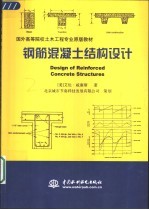图书介绍
钢筋混凝土结构设计 英文版PDF|Epub|txt|kindle电子书版本网盘下载

- (美)艾伦·威廉斯著 著
- 出版社: 北京:中国水利水电出版社
- ISBN:7508410017
- 出版时间:2002
- 标注页数:385页
- 文件大小:11MB
- 文件页数:394页
- 主题词:
PDF下载
下载说明
钢筋混凝土结构设计 英文版PDF格式电子书版下载
下载的文件为RAR压缩包。需要使用解压软件进行解压得到PDF格式图书。建议使用BT下载工具Free Download Manager进行下载,简称FDM(免费,没有广告,支持多平台)。本站资源全部打包为BT种子。所以需要使用专业的BT下载软件进行下载。如BitComet qBittorrent uTorrent等BT下载工具。迅雷目前由于本站不是热门资源。不推荐使用!后期资源热门了。安装了迅雷也可以迅雷进行下载!
(文件页数 要大于 标注页数,上中下等多册电子书除外)
注意:本站所有压缩包均有解压码: 点击下载压缩包解压工具
图书目录
INTRODUCTION1
1 MATERIALS FOR REINFORCED CONCRETE3
1.1 Basic Concepts3
1.1.1 Materials for concrete3
1.1.2 Properties of the concrete mix7
1.1.3 Mixing and placing8
1.2 Concrete Technology11
1.2.1 Durability of concrete11
1.2.2 Mix Proportions12
1.3.1 Control of concrete quality16
1.3 Mix Design16
1.3.2 Mix design criteria17
1.3.3 Mix design based on statistical data18
1.3.4 Mix design based on a prescribed margin20
1.3.5 Mix design based on a prescribed water-cement ratio21
1.4 Concrete Testing21
1.4.1 Testing the constituents of the mix21
1.4.2 Testing for consistency of the mix25
1.4.3 Testing of the concrete25
1.5.2 Tensile strength26
1.5.1 Compressive strength26
1.5 Concrete Properties26
1.5.3 Modulus of elasticity27
1.5.4 Creep28
1.5.5 Shrinkage29
1.6 Reinforcement Properties29
1.6.1 Deformed bars29
1.6.2 Welding reinforcement30
1.6.3 Corrosion protection31
1.7 Supplementary Problems32
References33
2.2 Ultimate Limit State Procedure37
2.2.1 Strength design requirements37
2 LIMIT STATE PRINCIPLES37
2.1.1 Limit state requirements37
2.1 General Concepts37
2.2.2 Design strength and reduction factors39
2.2.3 Design load and load factors39
2.3 Serviceability Limit State Procedure40
2.3.1 Working stress design method40
2.3.2 Serviceability criteria42
2.4.1 Load types43
2.4.2 Loading combinations43
2.4 Loading Conditions43
2.4.3 Loading arrangements44
2.4.4 Moment redistribution48
2.4.5 Approximate design coefficients54
2.5 Supplementary problems56
References57
3 FLEXURE OF REINFORCED CONCRETE BEAMS59
3.1 General59
3.1.1 Types of members59
3.1.2 Reinforcement detailing60
3.2.1 Rectangular beam with tension reinforcement only62
3.2 Strength Design62
3.2.2 Rectangular beam with compression reinforcement78
3.2.3 Flanged section with tension reinforcement only83
3.3 Serviceability Requirements88
3.3.1 Crack control88
3.3.2 Deflections92
3.3.3 Working stress design method97
3.4 Supplementary problems104
References107
4.1.1 General shear concepts109
4.1 Design for Shear109
4 SHEAR AND TORSION OF CONCRETE BEAMS109
4.1.2 Design of beams without shear reinforcement113
4.1.3 Rectangular beam with shear reinforcement116
4.1.4 Shear in deep beams126
4.1.5 Design of corbels130
4.2 Design for Torsion135
4.2.1 General torsion concepts135
4.2.2 Design of beams without torsion reinforcement137
4.2.3 Rectangular beam with torsion reinforcement138
4.3.1 Shear reinforcement148
4.3 Reinforcement detailing148
4.3.2 Torsion reinforcement149
4.4 Supplementary problems150
References151
5 BOND AND ANCHORAGE153
5.1 General153
5.1.1 Bond effects in reinforced concrete153
5.2 Anchorage Requirements157
5.2.1 Development length: straight bars in tension157
5.2.2 Development length: straight bars in compression162
5.2.3 Bundled bars163
5.2.4 Development length: hooked bars in tension166
5.3.1 Curtailment of flexural reinforcement169
5.3 Curtailment Requirements169
5.3.2 Positive flexural reinforcement172
5.3.3 Negative flexural reinforcement173
5.4 Reinforcement Splices178
5.4.1 Splice lengths for tension reinforcement178
5.4.2 Splice lengths for compression reinforcement182
5.4.3 Welded splices and mechanical connections185
5.5 Reinforcement detailing185
5.5.1 Empirical detailing procedures185
5.6 Supplementary problems186
References188
6 DESIGN OF REINFORCED CONCRETE COLUMNS189
6.1 General Principles189
6.1.1 Column instability189
6.1.2 Effective column length190
6.1.3 Slenderness effects192
6.1.4 Reinforcement detailing198
6.2 Short Columns200
6.2.1 Short columns with axial load only200
6.2.2 Short columns with applied moment212
6.3.4 Biaxial bending212
6.3.1 Determination of P-Delta effects216
6.3 Long Columns216
6.3.2 Magnified moments: non-sway frames217
6.3.3 Magnified moments: sway frames220
6.4 Transfer of force at base of column223
6.4.1 Transfer by bearing on concrete223
6.4.2 Transfer by reinforcement224
6.5 Supplementary problems227
References230
7.1 General231
7.1.1 Types of slabs231
7 DESIGN OF REINFORCED CONCRETE SLABS231
7.2 One-way Slabs232
7.2.1 Design of one-way slabs232
7.2.2 Deflection criteria233
7.2.3 Reinforcement detailing233
7.3 Two-way Slabs237
7.3.1 Design of two-way slabs237
7.3.2 Direct design method237
7.3.3 Shear requirements242
7.3.4 Deflection criteria252
7.3.5 Reinforcement detailing258
7.4 Supplementary problems259
References260
8 DESIGN OF FOOTINGS261
8.1 General261
8.1.1 Types of footings261
8.1.2 Reinforcement detailing262
8.2 Design Requirements263
8.2.1 Strip footing263
8.2.2 Isolated column footing266
8.2.3 Isolated column footing with eccentric load277
8.2.4 Combined footing282
8.2.5 Strap footing292
8.2.6 Eccentric footing298
8.3 Supplementary problems304
References307
9 RETAINING WALLS309
9.1 General309
9.1.1 Types of retaining walls309
9.1.2 General design considerations310
9.2 Cantilever and Gravity Walls311
9.2.1 Design of cantilever retaining walls311
9.2.2 Reinforcement detailing313
9.2.3 Gravity retaining wall323
9.2.4 Counterfort retaining wall325
9.3 Sheet Pile Walls328
9.3.1 Cantilever sheet pile wall328
9.3.2 Anchored sheet pile wall330
9.4 Supplementary problems337
References338
10 PILED FOUNDATIONS339
10.1 General339
10.1.1 Using piled foundations339
10.2 Pile Group with Vertical Piles340
10.2.1 Vertical loading only340
10.2.2 Vertical and lateral loading342
10.3 Pile Group with Inclined Piles344
10.3.1 No rotation of pile cap344
10.3.2 Rotation of pile cap346
10.4 Pile Cap Design351
10.4.1 Beam analogy method351
10.4.2 Truss analogy method355
10.5 Supplementary problems359
References361
APPENDIX363
Structural Design Programs for the HP-48G Calculator363
INDEX383